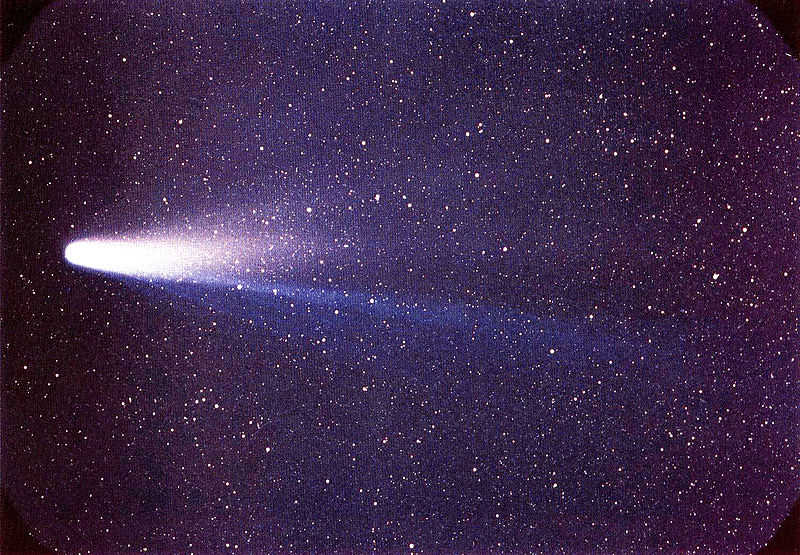Halley's Comet - Periodicity
Halley's Comet or Comet Halley, officially designated 1P/Halley, is a short-period comet visible from Earth every 74–79 years. Halley is the only known short-period comet that is regularly visible to the naked eye from Earth, and the only naked-eye comet that might appear twice in a human lifetime. Halley last appeared in the inner parts of the Solar System in 1986 and will next appear in mid-2061.
Halley's returns to the inner Solar System have been observed and recorded by astronomers since at least 240 BC. Clear records of the comet's appearances were made by Chinese, Babylonian, and medieval European chroniclers, but were not recognized as reappearances of the same object at the time. The comet's periodicity was first determined in 1705 by English astronomer Edmond Halley, after whom it is now named.
During its 1986 apparition, Halley's Comet became the first comet to be observed in detail by spacecraft, providing the first observational data on the structure of a comet nucleus and the mechanism of coma and tail formation. These observations supported a number of longstanding hypotheses about comet construction, particularly Fred Whipple's "dirty snowball" model, which correctly predicted that Halley would be composed of a mixture of volatile ices—such as water, carbon dioxide, and ammonia—and dust. The missions also provided data that substantially reformed and reconfigured these ideas; for instance, it is now understood that the surface of Halley is largely composed of dusty, non-volatile materials, and that only a small portion of it is icy.

Computation of orbit
Halley was the first comet to be recognized as periodic. Until the Renaissance, the philosophical consensus on the nature of comets, promoted by Aristotle, was that they were disturbances in Earth's atmosphere. This idea was disproved in 1577 by Tycho Brahe, who used parallax measurements to show that comets must lie beyond the Moon. Many were still unconvinced that comets orbited the Sun, and assumed instead that they must follow straight paths through the Solar System.
In 1687, Sir Isaac Newton published his Philosophiæ Naturalis Principia Mathematica, in which he outlined his laws of gravity and motion. His work on comets was decidedly incomplete. Although he had suspected that two comets that had appeared in succession in 1680 and 1681 were the same comet before and after passing behind the Sun (he was later found to be correct; see Newton's Comet), he was unable to completely reconcile comets into his model.
Ultimately, it was Newton's friend, editor and publisher, Edmond Halley, who, in his 1705 Synopsis of the Astronomy of Comets, used Newton's new laws to calculate the gravitational effects of Jupiter and Saturn on cometary orbits. Having compiled a list of 24 comet observations, he calculated that the orbital elements of a second comet that had appeared in 1682 were nearly the same as those of two comets that had appeared in 1531 (observed by Petrus Apianus) and 1607 (observed by Johannes Kepler). Halley thus concluded that all three comets were, in fact, the same object returning about every 76 years, a period that has since been found to vary between 74–79 years. After a rough estimate of the perturbations the comet would sustain from the gravitational attraction of the planets, he predicted its return for 1758. While he had personally observed the comet around perihelion in September 1682, Halley died in 1742 before he could observe its predicted return.
Halley's prediction of the comet's return proved to be correct, although it was not seen until 25 December 1758, by Johann Georg Palitzsch, a German farmer and amateur astronomer. It did not pass through its perihelion until 13 March 1759, the attraction of Jupiter and Saturn having caused a retardation of 618 days. This effect was computed prior to its return (with a one-month error to 13 April) by a team of three French mathematicians, Alexis Clairaut, Joseph Lalande, and Nicole-Reine Lepaute. The confirmation of the comet's return was the first time anything other than planets had been shown to orbit the Sun. It was also one of the earliest successful tests of Newtonian physics, and a clear demonstration of its explanatory power. The comet was first named in Halley's honour by French astronomer Nicolas-Louis de Lacaille in 1759.
Some scholars have proposed that first-century Mesopotamian astronomers already had recognized Halley's Comet as periodic. This theory notes a passage in the Bavli Talmud that refers to "a star which appears once in seventy years that makes the captains of the ships err." Researchers in 1981 attempting to calculate the past orbits of Halley by numerical integration starting from accurate observations in the seventeenth and eighteenth centuries could not produce accurate results further back than 837 due to a close approach to Earth in that year. It was necessary to use ancient Chinese comet observations to constrain their calculations.

Apparitions
Halley's calculations enabled the comet's earlier appearances to be found in the historical record. The following table sets out the astronomical designations for every apparition of Halley's Comet from 240 BC, the earliest documented widespread sighting. For example, "1P/1982 U1, 1986 III, 1982i" indicates that for the perihelion in 1986, Halley was the first period comet known (designated 1P) and this apparition was the first seen in half-month U (the second half of October) in 1982 (giving 1P/1982 U1); it was the third comet past perihelion in 1986 (1986 III); and it was the ninth comet spotted in 1982 (provisional designation 1982i). The perihelion dates of each apparition are shown. The perihelion dates farther from the present are approximate, mainly because of uncertainties in the modelling of non-gravitational effects. Perihelion dates of 1531 and earlier are in the Julian calendar, while perihelion dates 1607 and after are in the Gregorian calendar.
















0 comments
Sign in or create a free account